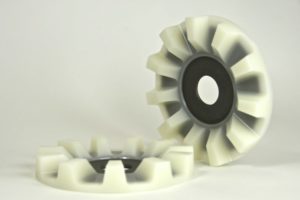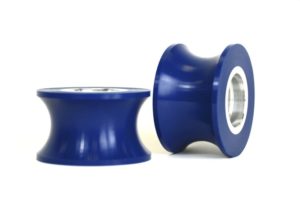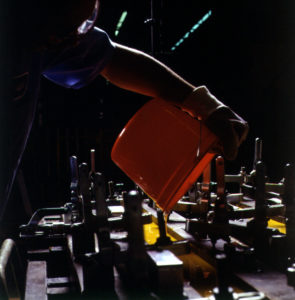Is Urethane Rubber?
Urethane is a member of the broader family of Rubber.
Rubber embraces a large group of materials. Materials that have the ability, under certain conditions, to undergo large deformations. Yet they recover almost completely on the release of the deforming force. This elasticity is due to the repetition of long molecular chains and cross-links of the base polymer.
Originally, rubber came from the tree Hevea Brasiliensis. Called Indian or natural rubber, its use dates back to the Mayan culture.
Since the 1930’s, at least 16 different man-made rubbers have been developed. They have different, improved, and controlled molecular structures. Familiar types are neoprene, nitrile, butyl, silicone, and urethane.
But, if superior abrasion and cut and tear resistance are important, consider urethane instead of rubber. Urethanes provide higher load-bearing capacity, compression set, and superior resistance to greases, oils, oxygen, and ozone.
Natural rubber is biodegradable. It will break down over time when exposed to the elements. Urethane is easily formulated to outlast rubber. When properly formulated, urethane will withstand exposure to sunlight and the outdoors.
Cast urethanes are available in many grades – clear, opaque or amber. Mixing with a variety of dyes or pigments — as required — is possible.
Rubbers in the 90A to 95A Durometer range have limited physical properties. The opposite is the case with urethane rubber.
Regardless of hardness, urethanes maintain their properties and performance characteristics.
There are ten major groups of urethane rubber:
- MDI-Polyesters:
- TDI-Polyester:
- MDI-Polyethers:
- Produce urethanes with higher resilience,
- better impingement type abrasion resistance,
- good dynamic performance,
- improved hydrolysis resistance, and
- excellent low-temperature properties.
- Some are adaptable to FDA and USDA application for wet and dry food contact.
- TDI-Polyethers:
- Have excellent low temperature and dynamic properties,
- microbial resistance, and
- long-term water resistance.
- TODI Polycaprolactone:
- Excellent heat resistance,
- hydrolysis resistance, and
- superior mechanical properties.
- PPDI: Terminated polyesters and polyethers offer superior performance at higher temperatures.
- MDI: Diphenylmethane Diisocyanate
- TDI: Toluene Diisocyanate
- PPDI: Paraphenylene Diisocyanate
- TODI: Toluidine Diisocyanate
Taken together, urethanes have:
- Oil, water and weather resistance, ozone and oxidation resistance, and resistance to many chemicals. Some are radiation, fungus, and bacteria resistant.
- High tensile and tear strength compared to other elastomers.
- Outstanding abrasion resistance compared to metals, plastics, and other elastomers.
- Higher load-bearing capacity than other elastomers.
- Higher impact resistance and resilience than plastics.
- Excellent retention of properties at very low temperatures and at temperatures up to 220°F (104°C). Bonded to metal to 160°F (71°C).
Also read: Why You Should Be Talking About Polyurethane and Urethane Versus Polyurethane
Contact Gallagher to see how we can put our knowledge and expertise to work for you.
What is an engineering material?
 Engineering textbooks contain hundreds of pages and charts. Many listing the properties of engineering materials. They are typically classified as metals or non-metals.
Engineering textbooks contain hundreds of pages and charts. Many listing the properties of engineering materials. They are typically classified as metals or non-metals.
The verbiage used to describe each classification can take up several paragraphs, pages or chapters — depending on how long the author wishes to think that he or she can hold the reader’s interest. “Metals are polycrystalline bodies which . . . blah, blah, blah.” Some go further in their classification of engineering materials. They include metals, ceramics, plastics, composites, and more.
But, what does it mean when we refer to an engineering material?
Merriam-Webster defines engineering as “the design and manufacture of complex products.”
By this definition, an engineering material would provide an open book for engineers and scientists. Based on the complex problems they are trying to solve, they could write their own properties.
This begs the question: “Do materials like this actually exist in today’s world?”
Throughout history, scientists, engineers, and metallurgists have worked hard. They’ve developed new materials with properties to solve specific sets of problems.
The time and expense necessary for this type of research and development are not justifiable for every product. But, what would it mean if engineers could design products and then customize a material to fit the needs of their application?
 Enter polyurethane elastomers — the ultimate engineering material.
Enter polyurethane elastomers — the ultimate engineering material.
What is a polyurethane elastomer? It’s not a metal or a ceramic, but it’s also not exactly a plastic or composite. Urethanes fall into the category of materials called rubber. But they’re not quite rubber either.
Urethanes fill the gap between rubber and plastic. They’re harder than rubber which contributes to their outstanding load-bearing abilities. Yet they’re softer and much more pliable than plastics.
This accounts for their outstanding impact resistance and all-around toughness.
The material properties of urethane are best when the elastomer formulation falls within the hardness range from about 60 Shore A to 70 Shore D.
Other hardnesses are achievable. But, certain material properties will suffer.
Elastomer formulations that fit this sweet spot can survive very large strains. Under certain circumstances, urethane can withstand strains as high as 50%. With little or no permanent plastic deformation. This trait alone is unheard of with most of the other materials available to a part designer. One would never expect a metal component to undergo 50% strain and recover to its original shape.
As already mentioned, polyurethane is a tough material. It has outstanding cut and tear resistance. This trait correlates with many useful properties.
One of the most helpful characteristics of urethane is its resistance to abrasion. Polyurethane elastomers will outlast metal, plastic, and rubber in abrasive environments. Many OEMs have converted legacy metal, plastic, or rubber components into polyurethane. This switch has improved the performance of their equipment offerings.
Niche businesses have sprung up to offer polyurethane replacement parts. Aftermarket suppliers to the agriculture, construction, and automotive industries now stock urethane alternatives. These polyurethane parts have replaced other materials providing enhanced performance and longevity.
 Another useful property within the control of the urethane molder is an elastomer’s resilience. Merriam-Webster defines resilience as: “the ability of something to return to its original shape after it has been pulled, stretched, pressed, bent, etc.”
Another useful property within the control of the urethane molder is an elastomer’s resilience. Merriam-Webster defines resilience as: “the ability of something to return to its original shape after it has been pulled, stretched, pressed, bent, etc.”
A good way to visualize urethane resilience is to visualize the shock absorber and spring on an automobile.
The shock absorber absorbs energy. While a spring stores energy when it’s compressed and then returns the energy back to the system. The springs prevent the passengers from bouncing around as the car travels down the road. The spring and shock absorber work together to provide a comfortable ride.
A polyurethane elastomer behaves the same way as an automobile shock absorber and spring. When it’s compressed or stretched, a certain amount of energy is absorbed — like a shock absorber. And a certain amount of energy is stored — much like a steel coil spring. The spring to shock absorber tendencies of a urethane part is adjustable through chemistry.
For example, if the need is a resilient material that will absorb very little energy. The urethane molder has the ability to provide a part that will return up to 80% of the energy applied. But, if the need is for a low resilience material designed to absorb energy (such as a vibration isolation pad). The urethane molder can adjust the chemistry to meet that need with ease.
 Another very unique and useful characteristic of urethane elastomers has to do with how it’s processed. In the raw state, urethanes are liquid. After mixing the liquid prepolymer with a liquid curative, the part is left to cure or solidify.
Another very unique and useful characteristic of urethane elastomers has to do with how it’s processed. In the raw state, urethanes are liquid. After mixing the liquid prepolymer with a liquid curative, the part is left to cure or solidify.
To get the best properties, the curing process takes place in the presence of heat. Heat helps drive the chemical reaction that forms the solid end product.
Starting with a liquid in the raw state has several benefits.
First, a liquid raw material makes customization not only possible but quite easy. You can adjust your final product to meet the requirements of a specific application. To do this, alter the ratio of prepolymer to curative or substitute one curative for another. For example, for a low compression set, the molder can reduce the amount of curative. In contrast, for better cut and tear resistance, the molder can increase the ratio of curative used.
Second, a liquid is pourable into molds at atmospheric pressure. This reduces the complexity and cost of tooling. As a liquid, the material will fill out thick and thin cross-sections in a mold. With polyurethane injection molding, the part designer can be more liberal in their designs. Requiring less attention to keeping a uniform cross-section thickness throughout the part.
The last processing benefit of starting with a liquid is the most important. The ability to bond urethane to other materials. With a bond strength that exceeds the strength of the urethane itself. Most often, this bond is between urethane and metal.
A bonded metal-urethane composite provides a great advantage to part designers. They can enjoy the best of both materials to solve complex problems.
For example, let’s consider a bonded metal-urethane engine mount. It utilizes the rigidity of the metal to attach the mount to other metal components such as the engine and chassis. But, the compliance of the urethane allows slight independent movements. Compensating for opposing forces and strains within the vehicle.
Contact Gallagher’s team of urethane experts for your next project.
